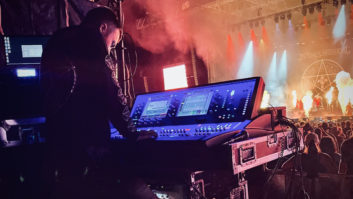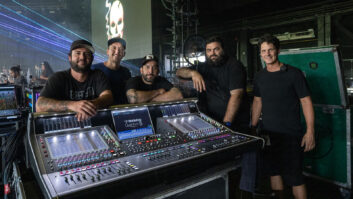Engineer Chris Mickle has been at the forefront of Webcasting concerts in the Colorado area for five years now since putting the first ISDN lines into Red Rocks in 1995 for a Blues Traveler show. And, because Webcasting is a fairly new field, Mickle has experienced his share of headaches getting the shows on the air.
“1996 proved an interesting year,” says Mickle. “I did Webcasts of two big shows that year and had trouble with the phone company with both of them. The first was the Hootie and The Blowfish Red Rocks concert, which was the first streaming Internet concert out of Red Rocks. We set up a conference call via an Internet phone service provided by Intel between the bandmembers and people all over the world on their computers. It was crazy. All the phone lines went down 15 minutes before the interview was to start. I still get goose bumps about it,” he laughs, pulling up his sleeve. “We got everything up and running again five minutes after the on-air time, which was a miracle. Then, later that year, we were to do a Big Head Todd and The Monsters Webcast from the Paramount, and two hours before a worldwide broadcast, we had no ISDN lines at the venue. Having been through this type of nightmare previously, I had direct contacts at U.S. West, which I used and kept using, and because we were all told the work had been done, they called a SWAT team in to install the ISDN modules and engage the lines with 15 minutes to spare.”
Mickle, now 48, got into engineering originally because he was “too broke” to record his own songs. Now he does the recording for many Colorado festivals, and his company, Professional Sound and Recording (PSR), regularly engineers remote recordings and Webcasts in Colorado and elsewhere, including a summer 2000 Puff Daddy show in London. In July 2000, PSR did the Webcast for the KBCO World Class Rock Fest in Winter Park, a two-day festival headlined by The Barenaked Ladies, Natalie Merchant, Kenny Wayne Shepherd, and Medeski, Martin and Wood. PSR produced the audio program, which was linked with a video company’s feed and sent out over the Net via the House of Blues uplink truck.
Mickle’s technical setup starts at the stage splitter, which routes all inputs to the house P.A., monitors and recording truck. “I also usually put up a couple of mics for ambience,” he says. Inside the truck, which can accept over 100 inputs, up to 40 inputs are routed to an Amek Einstein. “It’s a great-sounding, low-tech board,” says Mickle. “Our main console has 40 inputs, and our large second console has 24 inputs. We have two other sidecar consoles, each with 16 channels, and we have eight channels of Grace Design mic preamps, with more available.”
Inputs go directly from the preamps to the tape machines, normally Tascam DA-78s and DA-88s. Two Stephens 24-track machines are also available for 2-inch analog. Using the line-level returns from the tape machines, Mickle returns sources to the main console for monitoring and mixing. “Obviously, that way we have the cleanest, most direct signal to tracks,” comments Mickle. “I discourage the use of any effect or dynamic going to the tracks; we only use effects and dynamics on the mix side.”
Some of the Webcasts Mickle has worked on, like the Puff Daddy show, were recorded first and then posted on the Internet later. At other times, Mickle processes the signal right from the truck for streaming audio. When the show is a streaming audio production, such as the Winter Park festival, Mickle sends the signal from the board out to A/D converters. His preferences for converting the signal might surprise people. “I know you are looking for me to say I am using an Apogee or Prism, but I save that quality of conversion for the real audio processing in the truck. I feel any good A/D converter is suitable for the kind of Web broadcasting listening quality that is currently achievable today,” he explains. “I don’t think a better A/D converter would necessarily improve the end listener’s enjoyment of the broadcast. I think what improves the enjoyment of the broadcast is great processing of the signal prior to streaming. That comment might result in a lot of raised eyebrows from my peers in this business, but in an era where MP3 is completely acceptable to the vast majority of listeners, I fail to see how a $6,000 A/D converter will significantly improve the listener’s enjoyment over a very fine $2,000 converter.”
At the Winter Park festival, the final stage of Mickle’s production involved sending the show out live over the Internet, for which he uses the RME Hammerfalls sound card. From there, the signal chain can follow several branches. “Sometimes we use a dedicated piece of gear, like a [Telos] Zephyr for ISDN, but usually we are just sending it into a PC or Mac,” Mickle says. “From there it goes into the encoder; you can use MP3 or Winamp for that. You can also convert it to Real Player, Real Audio, QuickTime for Mac, Windows Media Player or Liquid Audio. Each one is its own specific process. Basically, you have a whole bunch of windows open, each of which is taking the data stream and processing it.” Certain clients, such as House of Blues or Liquid Audio, use a proprietary conversion process. “Typically, I am busy in the truck making sure the program is worth broadcasting,” laughs Mickle. “I leave it up to our associates to do most of the conversion.”
As well as using the PC for Internet audio, Mickle has been using the hard drive as a high-resolution backup for the tapes. “I am working on a project using Hammerfalls to record 48 tracks simultaneously to hard drive on a PC,” he explains. “Hammerfalls have the lowest latency and best written drivers; each card has 24 channels, and you can hook as many cards together as your system will allow.”
Broadcasting over the Internet often calls for multiple outputs at different resolutions. “One of our associates, Music Badger, Webcasts a lot of shows that we are involved with, and they take several MP3 conversions at once, as many as four,” explains Mickle. “Those converted MP3 streams are sent to different servers or high bandwidth hubs around the country or the world for distribution on the Internet. It has to be a high-bandwidth hub, because you will have hundreds of people dialing in simultaneously to pick up the program. One reason you send out so many streams is that some will be high quality for cable modems, DSL and ISDN connections, and you want to have some streams available for 28.8 to 56k modems, for people who don’t have the ability to pull down such dense data so fast.
“You have to have a couple of options out there,” he continues. “If you just send it out as high definition, then most of your potential audience won’t be able to participate. If you just send it out low definition, everyone might be able to participate, but it won’t be available to anyone as a high-quality broadcast. If you just sent it out low bandwidth, you won’t be able to convey how good it sounds; you want a high bandwidth signal to go out so that all your hard work in producing the broadcast shines through. One important aspect of either Internet or radio shows is to have your excellent mix compressed enough as it leaves the truck so that the compressors at the station, satellite or Internet don’t adversely affect the program. If you send it out too hot, then those kinds of compressors will wreak havoc on your show as it comes over the air.”
For those who think Internet streaming of shows is the future, or for those with a more negative worldview who think that it offers a great chance for piracy, Mickle has some sobering words. “I had the eye-opening pleasure of producing the very first Internet broadcast from Red Rocks in 1996, a Hootie and The Blowfish show,” he recalls. “It was a part of Intel’s new Internet phone service, and we spent days working out a system. Intel brought six Pentium Pro computers on-site for the production and had engineers for each PC. After the show was under way, I was able to listen through headphones to a return Internet line through one of the computers, and it sounded like a really cheap, ancient transistor radio.
“There were all these suits from brand new Internet companies watching our effort and seeing this dawning of a Webcast age,” he continues. “I remember, after initially hearing how it sounded through the computer, I went into the truck and grabbed Kevin Clock, my chief engineer, and had him listen as well. With the headphones on and without thinking about it, he looked at me and said quite loudly, ‘This sounds like crap.’ You could just see the blood drain from the faces of the executives around us,” laughs Mickle. “Of course, things are a lot better now, but I hope MP3 is not the final answer. I don’t know that I have experienced the full reservoir of MP3 material, from average quality to the best quality. I’ve been told some MP3s are pretty good, but I haven’t experienced it. I think as bandwidth improves, maybe through satellite technology, we will be able to come up with less intrusive techniques to transmit high-quality audio and video.”
Candace Horgan is a freelance writer based in the Denver area.





